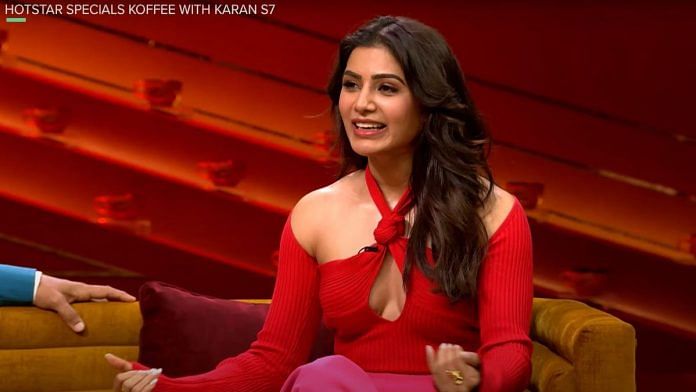There have only been two women movie stars who have taken on Karan Johar sitting on the Koffee with Karan couch—Kangana Ranaut and Samantha Prabhu. Both have bravely called out their powerful Bollywood host for hypocrisy.
In the latest episode of the seventh season of the talk show, after Johar kept on asking her about her personal life, Prabhu stopped him midway to “pick a bone” with him. She said, “You are, on some level, the reason for unhappy marriages. Because you have marketed this idea of marriage, wedding attires, and wedding songs. You know from our youth, you have portrayed life to be K3G [Kabhi Khushi Kabhie Gham]. When, in fact, the reality is K.G.F.” The filmmaker burst into laughter, but by that time, Prabhu had said what millennials have felt at some point or the other in our lives.
Much like Saif Ali Khan, who accompanied Ranaut in her episode in season 5, Akshay Kumar, seated next to Prabhu, was caught off guard. Kumar tried to lighten the moment by chiming in humorously. But by now, the arrow had left the bow. This wasn’t the solo moment in the show wherein she called him out on his double standards. At one point, referring to Prabhu’s previous relationship, the filmmaker said he doesn’t want to “encroach into her personal life”. Prabhu had a befitting response. “You already asked that off-screen. You mean you’re not going to ask in front of the camera (sic),” she said with a smile.
If the 2017 episode of Koffee with Karan with Kangana Ranaut was the “weirdest”, the 2022 episode with Prabhu would, perhaps, be the bravest.
Also Read: Koffee With Karan has no guts to reinvent itself. Bollywood has changed, rapid-fire hasn’t
Why brave
When Ranaut had described Johar as the “flagbearer of nepotism” five years back, she stroked the sleeping elephant in the proverbial room [read: Bollywood]. The ‘n’-word was no new revelation. It had existed in theory and practice since time immemorial in film industries or any industry for that matter, but it was not until Ranaut dropped it, that it became the most popular word of the year.
Soon after Ranaut’s words broke the internet, Johar said in an interview that if she had so many issues with the film industry, she should “leave it”. It cannot be an easy position to be in if one of the most influential filmmakers in your industry shuns you in such a manner publicly.
While Ranaut struck a sensitive and controversial chord with her statement, Prabhu voiced the millions of millennials struck by the cupid brewed at Karan Johar School of Romance. In the last few years, Prabhu has evolved to become one of the most successful female actors in the country. Even the Ormax rating shown on the show is a testament to her successful graph. For an actor of her stature to call out Johar is no mean feat.
Also Read: Titillation, titillation, titillation — what Karan Johar’s Koffee with Karan is all about
Problems with KJo’s films
If you are a millennial and are familiar with Bollywood, chances are you have grown up watching Johar’s romantic or family dramas.
In his directorial debut, Kuch Kuch Hota Hai (1998), Rahul does not pay attention to Anjali until she transforms into the stereotypical definition of how a girl should be—long hair, ethnic clothes et al. In his next film Kabhi Khushi Kabhie Gham (2001), Rahul was disowned for marrying someone he loved or how he led on Naina when he was clearly not into her. In his 2003 film Kal Ho Na Ho, Aman introduces a formula to woo a girl—“6 din, ladki in (Six days to woo a girl)”.
And let’s not even get into the persistent body-shaming portrayed in most of his films by the central characters. Interestingly, author Shrayana Bhattacharya says in her book Desperately Seeking Shah Rukh that “Shah Rukh Khan romantically ruined women—married, working, mothers”—courtesy of his characters in romantic films of the ‘90s.
In a poor form of recovery, Johar said that he also marketed divorce in his film Kabhi Alvida Naa Kehna (2006). Prabhu is quick to correct him, “Much later, when everything had already sunk”. I couldn’t agree more.
Views are personal.
(Edited by Srinjoy Dey)






